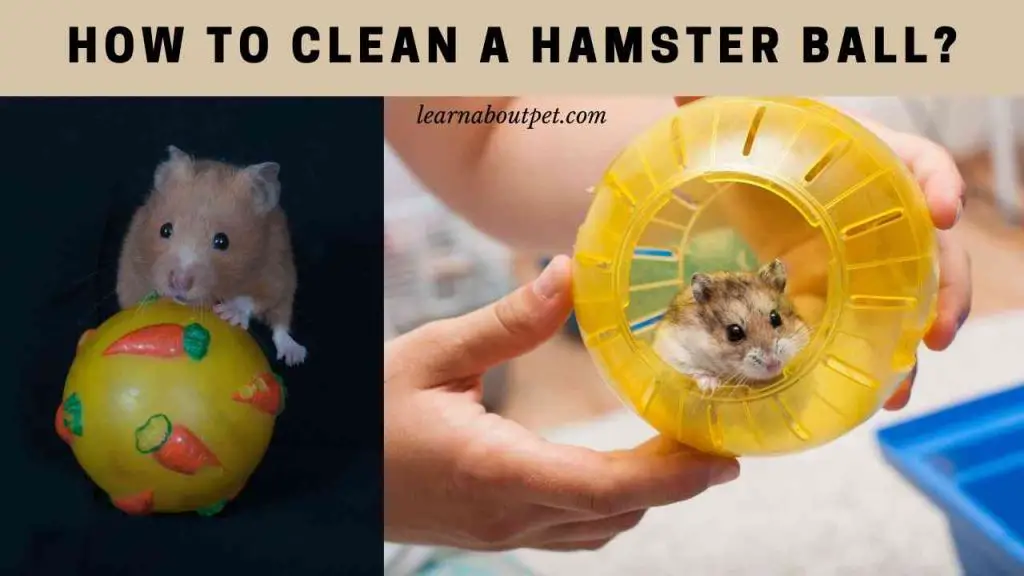Even though hamsters are part of the NAC (new pets), these little rodents have been around people for a very long time. But this complicity does not mean that we know how to take care of them properly, or even how to handle them properly. That’s the problem, you can’t catch a hamster like you catch a cat!
The hamster may be a small animal, but that doesn’t prevent it from needing to exercise. Many owners choose to give their hamsters a safe exercise ball to let them out of their cage. However, hamsters being hamsters make the balls dirty and owners may have to take the trouble in understanding the cleaning process of the ball.
How to clean a hamster ball? Hamster balls can be cleaned, first rinsed with water to remove any debris or dirt then use a sponge with an antibacterial soap.

But many German and Swiss associations consider that exercise balls for hamsters are harmful to the hamster. animal, which is why they are banned in Switzerland. But then, how are they dangerous for our little hamsters? Let’s dive in.
How To Clean A Hamster Ball?
A hamster ball is a very popular tool for hamster exercise but owners often ask how to clean a hamster ball? A hamster ball can be cleaned in different ways.
Hamster ball can be cleaned through following ways
- Hamster ball can be cleaned with simple water and soap – Rinse the ball with water, taking off any solid residue or dirt, apply a little soap then rub the soap gently with fingers and rinse it again with water.
- Boil the ball after rinsing it through water – After rinsing all solid particles from the ball through water, owners can boil the ball with warm water. This method takes all the dirt and bacteria off the ball. The water shouldn’t be too hot and it should be kept for some time so that the temperature of the ball comes to room temperature before putting the hamster in the ball again.
- By using only a cleaning cloth – If the ball isn’t a lot dirty then the ball can also be cleaned with a hand towel. Owners should gently press the towel inside and out thoroughly on and in the ball.
The Risks Of The Exercise Ball For Hamsters
The first problem with the hamster exercise ball is that it poses a risk of injury to your hairball. By dint of rolling right to left, the ball bumps into furniture. Each shock is violent for the little beast inside the ball, which then risks falling and being hurt.
In addition, very often the balls are poorly designed. For example, it is not uncommon for exercise balls to not have enough ventilation, to the point that the hamster can suffocate in them, especially if they exercise a lot. In addition, these spheres are often too small, which causes back problems for rodents who use them.
An exercise ball is also risky if it is unhygienic and dirty so the owners should learn how to clean a hamster ball.
A Stressful Activity For Hamsters
It is also necessary to take into account the little interest that this activity presents for hamsters. Locked in a ball, they cannot interact with their environment, nor explore it, which in itself is one of the main objectives, when you take your hamster out of its cage. Worse yet, this plastic sphere in which they are trapped subjects these fragile little animals to significant stress, leading to heart problems.
Indeed, the often colored exercise ball disturbs the hamster’s vision, which loses its bearings. This adds to the total instability offered by this small rolling cabin. Because the exercise balls are in constant movement: once the hamster has started to roll, it is as if obliged to continue so as not to be carried away by its ball. Unable to get out or stop, it gives the impression of loving riding when in reality just would like it to stop!
Stressful and dangerous, the hamster exercise ball is therefore far from being the miracle solution that some pet stores can boast. A large cage reserved for games or a secure park would seem to be more advantageous alternatives for these fragile little rodents.
How To Clean A Hamster Ball?
To clean a Hamster ball, owners can use three options that are cleaning with water and soap, boiling after rinsing and cleaning it with a towel or paper napkin. This is how to clean out a dirty hamster ball.
Learning how to clean out a hamster ball is important to maintain pet hamster health if the ball is not dirty.
How Do You Clean A Hamster Bowl?
A hamster feeding and drinking bowl should be cleaned every day with a sponge and soap gently rubbing soap on the bowl. It is advised to change the bowl every 3 months for hygiene purposes.
How Often Should You Put Your Hamster In A Ball?
How often should hamsters go in their ball? The hamsters shouldn’t play in their balls for more than fifteen to twenty minutes per day. This will ensure that the hamsters get ample exercise and at the same time don’t get too dehydrated.

Can You Take Apart A Hamster Ball?
Yes, the ball can be taken apart to put the hamster in and out of it and to clean the ball from inside.
How To Take Apart A Hamster Ball?
Most of the hamster balls are designed to open by twisting the centre of the ball. Twisting the ball will make it open from two sides by which it can be cleaned and put into the hamster.
How to take apart a Kaytee hamster ball? The procedure is same as just like any other hamster ball.
Can You Bathe A Hamster In Water?
No, hamsters strictly can’t bathe in the water. Watersheds away the natural oils present in their hair.
How To Clean Hamster Cage With Vinegar?
Vinegar should be mixed with water. The ratio should be 50-50. Spraying the mixed liquid will be convenient.
What Is Sand Bath For Hamsters?
A sand bath is recommended over a water bath. It will remove the don’t off the hamsters. Just put some sand in a big bowl and add the hamster to it.
How Often Do You Clean A Hamster Cage?
The cage of a hamster should be cleaned at least once a month.
How Often Do You Clean A Dwarf Hamster Cage?
The cage of a dwarf hamster should be cleaned at least once a month.
How To Open A Hamster Ball To Clean It?
Generally, an ordinary hamster ball will open by twisting it from the center.
How To Close A Hamster Ball?
The hamster ball closes by twisting it to the other side of the opening.
Final Verdict – How To Clean A Hamster Ball
Hamsters are one of the most loved pet animals. Their low maintenance and calm nature make them an ideal pet for people from different faces of life. Many people bring home the hamsters as a pet before even understanding the basics. The most common question asked about hamsters, an owner may ask is how to clean a hamster ball?
A hamster shouldn’t be given a water bath. Water can damage the natural oils present on the hairs of hamsters. Taking away the smoothness and a protective layer from their bodies also makes them more vulnerable to diseases and infections. A sand bath is recommended for a hamster. Putting some clean and dry sand in a bowl will do the work.

Furthermore, hamster balls are also very popular but hamsters shouldn’t be given ball exercise for more than fifteen to twenty minutes. Hamster balls can be cleaned by opening them and rinsing them with water and soap or by boiling the ball or spraying an equal amount of mixture of vinegar and water. If the ball isn’t very dirty, it can also be cleaned with a towel. Make sure to read the Hamster husbandry guide.
As a pet lover, make sure to learn about pet more and give your pet hamster a good and comfortable life!

Welcome to Learn About Pet. My name is Rajkumar Ravichandran and I love all pets, travel, and amazing food. I write about my passion and personal experience caring for multiple pets in this blog! ❤️
Post Disclaimer
DISCLAIMER: THIS BLOG OR WEBSITE, "Learn About Pet", DOES NOT PROVIDE YOU WITH MEDICAL ADVICE AND IS NOT A SUBSTITUTE FOR MEDICAL ADVICE. ALWAYS GET IN TOUCH WITH YOUR PERSONAL VETERINARIAN AND USE INFORMATION HERE AS GENERAL ADVICE.
The information, including but not limited to, text, graphics, images and other material contained on this website are for informational purposes only. No material on this site is intended to be a substitute for professional veterinary advice, food recommendation, diagnosis, or treatment. Always seek the advice of your veterinarian or other qualified health care provider with any questions you may have regarding a medical condition or for pet food related questions.







